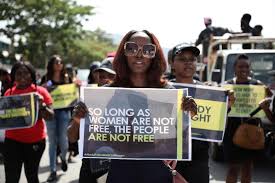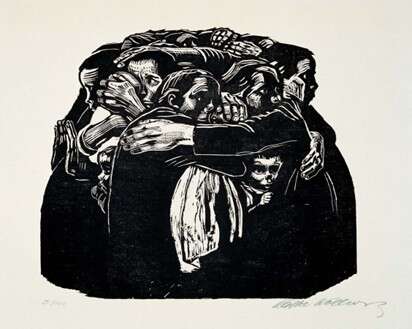Feminist Miseducation in the Afro-West: Examining (In)Formal Gender Indoctrinations

Introduction
Gender conflict is one of the fundamental problems embedded in the socio-cultural framework of African society (Amadiume 23). Its omission from Kwesi Prah’s list of Africa’s most pressing issues reveals how deeply overlooked this issue remains in administrative and intellectual discourse. Prah cites “ethnic conflict, cultural oppression, rights of minorities, African nationalism, and democratic organization” as the continent’s central challenges but notably leaves out gender conflict, even though this could also be categorized under the rights of minorities (23). In the twenty-first century, gender conflict continues to be deprioritized, often concealed under what I refer to as feminist miseducation propaganda, an ideology embedded in the pedagogical foundations of many African nations.
By “feminist miseducation,” I refer to the widespread misunderstanding, distortion, and misrepresentation of feminist ideas, history, and goals, often caused by both misinformation and deliberate manipulation. These two forces work simultaneously within the ideological frameworks shaping public perception. Drawing on bell hooks’ definition, one I find both accurate and original, “feminism is a movement to end sexism, sexist exploitation, and oppression” (2). However, in the African context, feminism is frequently stereotyped as man-hating or dismissed altogether as a redundant movement, reduced to a phantom revolution based on the belief that women already have rights. What more do they want? The lingering question remains: Do African women truly possess socio-political rights within their societies?
To explore this question, let’s turn to a recent high-profile case in Nigeria. On March 6, 2025, Senator Natasha Akpoti-Uduaghan, who represents Kogi Central, was suspended for six months by the Nigerian Senate after filing a petition accusing Senate President Godswill Akpabio of sexual harassment (Channels Television). No investigation was conducted. What followed was even more telling: public backlash, including condemnation from other women who staged protests against her for speaking out. One protester declared, “Natasha should face her husband and leave Akpabio alone” (Arise News 8:58-9:01). The same woman added, “A man is free to look at a woman. That is the end. She should stop blackmailing Akpabio” (9:02-9:08). Here again, a woman was blamed for a man’s misconduct and publicly shamed for daring to speak up, while the man’s actions are grossly justified. Incidents like this expose a troubling pattern, one in which many Nigerian women are discouraged from reporting harassment for fear of societal condemnation. If a sitting senator can suffer such severe consequences for speaking out, what hope is there for the ordinary woman?
This case illustrates how formal power structures and informal public reactions suppress feminist advocacy. The widespread misunderstanding of feminist politics reflects the reality that most people learn about feminism through patriarchal mass media (hooks 4). While the protest against Senator Akpoti-Uduaghan was disturbing, it is not an anomaly within Nigeria’s socio-cultural framework. More troubling is that such attitudes are reinforced not only through media but also within the home and the formal education system. Both formal and informal education in Africa have long encouraged female silence and subservience. Many women raised in this system do not view these beliefs as problematic because, from an early age, they are taught, often by their mothers and grandmothers, that male dominance is natural. As bell hooks notes, the strongest patriarchal voice in her life was her mother’s (3). In many African cultures, mothers have passed down the idea that a man’s gaze is inevitable, that shrinking oneself to accommodate male presence is a virtue, and that speaking loudly, especially in opposition to men, is unladylike. Thus, the protester’s outburst, “We no need stubborn people like Senator Natasha” (Arise News 6:40–6:45), reveals how society perceives fearless, vocal women as threats to patriarchy.
This ingrained belief system also manifests in schools. Young girls are often conditioned to seek approval and avoid confrontation, making them more likely to excuse or defend the misconduct of their male peers than to challenge it. The issue extends beyond the gender indoctrination children receive at home. It includes the narratives embedded in textbooks, classroom interactions, and media representations used in schools. This cycle continues when outdated gender roles are subtly or explicitly reinforced within educational settings. Therefore, feminist miseducation in Nigeria is not merely a cultural byproduct, it is embedded within structured learning environments.
This paper analyzes how informal and formal educational systems hinder feminist progress in the Afro-West by enforcing a culture of domestication that trains women into silence, compliance, and a patriarchally distorted version of modesty. It further examines the nature of gender indoctrination in both public and private spheres, as well as the role of state machinery, or state-sponsored misogyny, in impeding gender justice and fueling backlash against feminist movements. I use the term “Afro-West” in this study to describe the cultural fusion of African and Western influences. This framing is especially relevant in post-colonial societies where Western systems were imposed or adopted, leading to hybrid gender norms and ideologies. I argue that certain gender dynamics, and by extension, gender indoctrination, within African societies are significantly influenced by Western norms, values, and systems.
Drawing on Ifi Amadiume’s theory of pre-colonial African matricentricism, I explore how subservience was embedded in African educational systems through colonialism and the spread of Christian education. However, feminist miseducation does not depend solely on European religio-cultural influences; it also stems from traditional patriarchal norms entrenched in African familial hierarchies. Although Amadiume highlights the pre-colonial Igbo tradition where women served as family heads (83) and the use of the non-gendered term mmadu, meaning person or human being, as opposed to the European male-centered term man (19), this does not erase gender bias. Women have long been viewed primarily as vessels for reproduction and pleasure in African societies. These beliefs, passed down through generations, continue to shape early and late-stage indoctrination in both informal and formal settings. This study explores how those indoctrinated ideologies continue to define the boundaries of female identity, agency, and resistance in the Afro-West.
Formal Education and the Cultivation of Silence
Schools, particularly through curriculum materials, play a vital role in shaping gendered outlooks and behaviors (Gebregeorgis 119). Primary education is foundational in orienting a child’s perspectives on social issues. At this critical stage, embedding particular ideologies within school curricula becomes especially impactful. In many African societies, elementary school textbooks, especially in subjects like English Language, Social Studies, and Home Economics, are often used to instill stereotypical concepts about the roles of men and women. Recognizing that textbooks transmit both universal values and communal norms, some educational institutions adopt materials that reinforce specific gender biases.
Africa, as a continent composed largely of developing nations, is predominantly patriarchal. The idea that women are subordinate to men is deeply embedded not only in social interactions and policies that regulate women’s bodies, but also in formal education systems. A study by Mawere in Zimbabwe revealed the dominance of masculine perspectives in education, perpetuating unequal gender relations and reinforcing male supremacy (Mawere 2). He also draws on Risman’s findings, which show that Ethiopian social studies textbooks underrepresent and stereotype women and girls (4). Gebregeorgis expands on this through a detailed analysis of the English for Ethiopia Students Book for grade four, used nationwide by students aged 11 to 13 (126).
Using direct excerpts from this textbook, Gebregeorgis observes that male characters are typically portrayed as knowledgeable figures who share skills and wisdom, often positioned as role models for their sons and other boys (128). In contrast, female characters are seldom depicted in active teaching roles, especially within the family setting. While women are acknowledged as having knowledge, their participation in knowledge-sharing is often framed in generalized or domestic contexts. This imbalance becomes more apparent in the comparison of two characters, Rahima and Ujulu. Rahima, a girl, is portrayed as waking early to complete numerous household chores such as cooking dinner, washing dishes, and cleaning the kitchen. Ujulu, a boy, has far fewer domestic responsibilities and ample time for rest and leisure (129). These portrayals reinforce the belief that women are naturally suited to domestic roles.
Mawere further critiques curriculum materials for promoting what he calls “masculine firstness”, in which masculinity is seen as the first and principal position in society (6). A key example of this is the consistent ordering of male nouns or pronouns ahead of female ones in educational texts and speech patterns, such as “Mr and Mrs,” “Brother and Sister,” and “Husband and Wife” (Mawere 6). This linguistic pattern reflects and reinforces a gender hierarchy, positioning women as secondary. While this ordering can be traced to patriarchal cultural and historical norms, its continued use in formal education perpetuates the notion that women occupy a second-class status (10). These norms contribute to environments where women face barriers to realizing their full potential (Arise News 22:49–22:55).
The use of male-centric pronouns and nouns, such as “he” and “man”, in school curricula further supports gender stereotypes by promoting masculine generics that obscure or exclude women (Mawere 11). Mawere’s analysis of HSS textbooks reveals how terms like “man-made disasters,” “policeman,” “fisherman,” and “skilled manpower” convey male dominance and visibility, while rendering women invisible in both domestic and public spheres (11). This use of “man” to represent all humans subtly pushes women to the margins of representation. Amadiume’s theory situates this practice within a broader colonial legacy, noting that such gendered language stems from Western and biblical influences. After all, formal education in West African countries was started with “the advent of foreign missionaries and the various colonial governments that colonized the sub-region” (Tuwor and Sossou 364).
Amadiume offers a compelling contrast by pointing to the Igbo term mmadu, a non-gendered word meaning “person” or “human being,” as the traditional marker of shared humanity (19). Unlike the European male-centric concept of “man,” mmadu reflects a more inclusive linguistic worldview. Christianity and the Bible, central pillars of both formal and informal education, have played a significant role in advancing gender indoctrination. Subjects like Christian Religious Studies often promote ideals that encourage submissiveness and silence in girls, aligning with the values demonstrated by certain female biblical figures or directives aimed specifically at women.
Beyond textbooks, the attitudes and practices of teachers also contribute to gender inequality in school environments. Leadership structures in many West African primary and secondary schools often follow the “masculine firstness” model, with male students commonly appointed as Head Prefects, while female students serve as their assistants. This hierarchy reinforces the notion that leadership is inherently male, while women are relegated to supporting roles. In my own elementary school experience, I was repeatedly told not to aspire to certain leadership positions because they were “reserved for boys.” These messages discourage girls from seeing themselves as leaders and normalize male dominance as a cultural expectation. Such beliefs establish a strong foundation for female subjugation in spaces that should instead empower them.
This educational model instills in girls a culture of obedience, reverence for authority, and deference to male leadership from an early age; a pedagogical approach that reinforces patriarchy. The primary lesson is to learn obedience to authority (hooks 4). Many educational systems actively omit or distort crucial gender-relevant content, such as consent, gender rights, and feminist history, in both primary and secondary curricula. According to hooks, education should serve as a practice of freedom. Yet for the African girl child, the classroom often becomes a site of patriarchal control and social conditioning (hooks 5).
The male child is not left untouched by this system. He, too, is socialized to believe in his natural dominance and entitlement. As he matures within this educational structure, he internalizes a patriarchal worldview that limits not only girls’ development, but also his own capacity for a more inclusive, feminist understanding of society.
Informal Indoctrination and the Culture of Domestication
The culture of domestication often reinforced through school textbooks where men go to work and women stay home to cook, clean, and care for children is only secondary to the deeper indoctrination rooted in family socialization. Mothers, grandmothers, and older female relatives often pass down patriarchal norms by training children according to gendered expectations. These women, positioned as the custodians of “feminine” values, teach girls that the home is the woman’s natural domain and that procreation and nurturing are her primary social responsibilities (Lado 33). As a result, girls are predominantly raised to be married off and to become good housewives. Many African women would attest to hearing phrases like, “Is this how you will behave in your husband’s house?” or “I am teaching you this so you don’t disgrace me in your husband’s house,” while being taught certain values at home.
Masculine firstness is further replicated in the cultural bedrock and Indigenous proverbs of certain African languages. For instance, the Igbo saying, “Ugwu nwanyi bu di ya”, which means a woman’s pride is her husband, and the Yoruba proverb, “Omokinirn àrôlé, Omobinrin agbära”, meaning “A male child is the pillar of the family, a female one is a seasonal stream” (Oluwole 105), serve as examples of how male superiority is embedded in social construct. In many households, male children are excused from domestic chores, while girls are expected to master cooking and cleaning. A messy room is overlooked as “boys being boys,” but any untidiness in a girl’s space is condemned. Girls are also taught to bend properly while sweeping, sit modestly, and stand gracefully, all in service of maintaining a “feminine posture.” Moreover, they are warned not to speak to their male siblings in certain ways, regardless of age, simply because those siblings are male. This dynamic shows that while textbooks reinforce female subjugation through formal education, “home training” ensures the culture of domestication and subservience takes root within the child’s most familiar environment—the home. Since children often model their worldview after home experiences, they inevitably internalize this skewed education and carry it into their interaction with society.
Religion offers no sanctuary from these constructs. Christianity, Islam, and African Traditional Religions, widely practiced across the continent, function as powerful tools of gender indoctrination. As socio-cultural systems, these religions play central roles in defining gender categories and legitimizing gender hierarchies (Lado quoting Castelli 68). Since the latter half of the twentieth century, religious movements within Christianity and Islam have increasingly rallied around the preservation of “traditional” gender roles, promoting male leadership and female domesticity (67). One of the most frequently cited justifications in Christianity is the Bible passage:
Wives, submit to your own husbands, as to the Lord. For the husband is the head of the wife, as also Christ is the head of the church; and he is the Saviour of the body. Therefore, just as the church is subject to Christ, so let the wives to their own husbands in everything (New King James Bible, Eph. 5.22-24).
This passage has repeatedly been used to excuse domestic violence and abuse, suggesting that a woman who disobeys her husband is spiritually defiant and deserves “discipline.” Alarmingly, some women themselves have cited similar verses as justification for enduring abuse and marginalization.
Beyond legitimizing hierarchy, religion also amplifies the regulation of women’s appearances and behavior through modesty doctrines. These doctrines are often translated into public policies and laws that target women’s bodies. In 2008, Nigerian Senator Eme Ufot Ekaette, Chair of the Senate Committee on Women and Youth Affairs, introduced “A Bill for an Act to prohibit and punish public nudity, sexual intimidation and other related offences in Nigeria,” popularly known as “The Indecent Dressing Bill” (Bakare-Yusuf 2). Framed as a response to rising immorality and sexual violence allegedly caused by women’s attire, the bill proposed up to three months in prison for public nudity and three years for sexual intimidation. It also encouraged religious bodies to play a central role in what was described as “moral rejuvenation.” Notably, no comparable laws have ever been introduced to regulate how men dress. This double standard contributes to the widespread victim-blaming of women who report sexual harassment or assault, with many being accused of provoking their abusers through how they dress. A recent example includes Senator Akpabio’s Special Assistant, Patrick Mfon, accusing Senator Natasha Akpoti-Uduaghan of wearing a transparent outfit to seduce the Senate President (Arise News 2:26–2:45).
It appears that virtually every space capable of educating or shaping public consciousness—family, religion, and school—is weaponized to indoctrinate gender inequality and reinforce patriarchal bias. The media is no exception. In a study analyzing portrayals of women in Nigerian newspapers, Ahmed observes recurring expressions like, “The woman is the engine room for the birth and upbringing of children” (89), and “Men are like leopards” (92). These starkly gendered descriptions position child-rearing as exclusively female and associate men with aggression and power. Further analysis from Ahmed revealed that women are consistently framed as commodities, the weaker sex, housekeepers, or even likened to plants and animals (92), revealing the appalling reality of media infiltration in feminist (de)theorizing. As Omotoso points out, media representations are deeply contextual and culture-dependent (2067). It is therefore unsurprising that African media mirrors the patriarchal systems entrenched in society, contributing to a dismal landscape of female representation.
This raises critical questions: Can feminism in Africa overcome the socio-cultural barriers that impede its progress? Can figures like Senator Akpoti-Uduaghan make meaningful strides toward gender justice in a system so deeply rooted in Afro-Western patriarchy?
Conclusion
The operation of gender indoctrination at the core of African society enables the continued spread of feminist miseducation. As a result, feminism is often perceived with suspicion in Africa, regarded as incompatible with African values (Atanga 304), and mischaracterized as misandrist or anti-family (hooks 2). In many African societies, declaring oneself a feminist typically provokes one of three reactions: cautious curiosity, open disdain, or social distancing. Women who publicly embrace feminism, especially in media spaces, are frequently subjected to marriage-shaming, cyberbullying, and threats. Consequently, African feminists are sometimes compelled to reassure society that their stance is not rooted in malice toward men.
Despite the creation of various terms aimed at emphasizing the inclusivity of feminism, the word “feminism” remains heavily stigmatized in African contexts. This enduring resistance stems from a deeper pedagogical crisis, one that is sustained by both formal and informal systems of gender miseducation. To address this, we must return to the foundations where gender norms are first taught and reinforced.
To move toward a more equitable future, feminist re-education in Nigeria must begin with comprehensive and strategic interventions. These should include: curriculum reform that critically engages with gender roles, power dynamics, and feminist thought across educational levels; media literacy campaigns to help individuals, especially young people, critically analyze gender representations and challenge stereotypes; community-based feminist teaching, rooted in local contexts, that makes feminism accessible and relevant to diverse audiences; and empowering grassroots feminist movements through funding, visibility, and policy support to ensure that change starts from the ground up. While dismantling deeply rooted systems of gender indoctrination is a long and difficult process, recognizing how these systems function is the first step toward meaningful transformation. Only by challenging both the visible and invisible forces that shape gender beliefs can we hope to shift public consciousness and build a society where feminism is not feared but understood and embraced.
Works Cited
Ahmed, Umar. “Metaphor in the Construction of Gender in the Media Discourse: Analysis of Metaphors Used to Describe Women in Nigerian Newspapers.” International Journal of Gender and Women’s Studies, Vol. 8, No. 1, 2018, pp. 88-99.
Amadiume, Ifi. Re-Inventing Africa: Matriarchy, Religion, and Culture. Zed Books, 1997.
Arise News. “Akpabio Vs Natasha Protesters Clash + Natasha Submits Petition + Akpabio Denies Allegations | OjyOkpe.” YouTube, 15 April 2025, https://www.youtube.com/watch?v=giyPwf6ozRA.
Atanga, Lilian Lem. “African feminism.” Gender and Language in Sub-Saharan Africa: Tradition, Struggle and Change, 2013, pp. 301-314.
Bakare-Yusuf, Bibi. “Of Mini-Skirts and Morals: Social Control in Nigeria.” Open Democracy, vol. 22, 2012, https://www.proquest.com/docview/1024693544/5DE1B68316CB416BPQ/8?accountid=12347&sourcetype=Magazines.
Channels Television. “Senate Suspends Natasha Akpoti-Uduaghan for Six Months.” YouTube, 15 April 2025, https://www.youtube.com/watch?v=yg0VB91N6k8.
Gebregeorgis, Mehari Yimulaw. “Gender Construction Through Textbooks: The Case of an Ethiopian Primary School English Textbook.” Africa Education Review, vol. 13, no. 3, 2016, pp. 119-140, https://doi.org/10.1080/18146627.2016.1224579.
hooks, bell. Feminism is for Everybody: Passionate Politics. Routledge, 2015.
—. Teaching to Transgress: Education as the Practice of Freedom. Routledge, 1994.
Lado, Ludovic. The Politics of Gender Reform in Africa: Family, Religion, and the State. University of Notre Dame Press, 2023.
Mawere, Daniel. “A Content Analysis of Gender Representation in Primary School Heritage-Social Studies Textbooks in Zimbabwe.” The Dyke, vol. 17, no. 2, 2024, pp. 1-18, https://hdl.handle.net/10520/ejc-dyke_v17_n2_a3.
Oluwole, Sophie B. “Culture, Gender, and Development Theories in Africa.” Africa Development, vol. 22, no. 1, 1997, pp. 95-121, https://www.jstor.org/stable/24482785.
Omotoso, Sharon Adetutu. “African Women and the Mass Media.” The Palgrave Handbook of African Women’s Studies. Springer International Publishing, 2021, pp. 2063-2079.
Prah, Kwesi. “Anthropology in Africa: Past, Present and New Visions.” Codesria Bulletin, vol. 3, 1991.
The Holy Bible. New King James Version, Thomas Nelson Inc., 1982.
Tuwor, Theresa, and Marie-Antoinette Sossou. “Gender Discrimination and Education in West Africa: Strategies for Maintaining Girls in School.” International Journal of Inclusive Education, vol. 12, no. 4, 2008, pp. 363-379, https://www.tandfonline.com/doi/epdf/10.1080/13603110601183115?needAccess=true.
Read more at By Rosemary Kasiobi Nwadike.
Articles, Education, Resistance, Social JusticeRelated News
News Listing

By Joban Sihota ➚
Natural disaster and civic literacy— Language acquisition in the wake of DANA
Articles, Cultural Pedagogy, Education, Public Education
July 8, 2025

By Alexis Andrade ➚
Radical Love: A Revolutionary Force for Liberation
Articles, Cultural Pedagogy, Resistance
June 26, 2025

By Jovana Paramentic ➚
Commodifying Mental Health: Online Therapy Platforms Operating Within a Neoliberal Framework
Articles, Social Justice
June 25, 2025
